Go loco: top 10 autumn city breaks in Europe by train
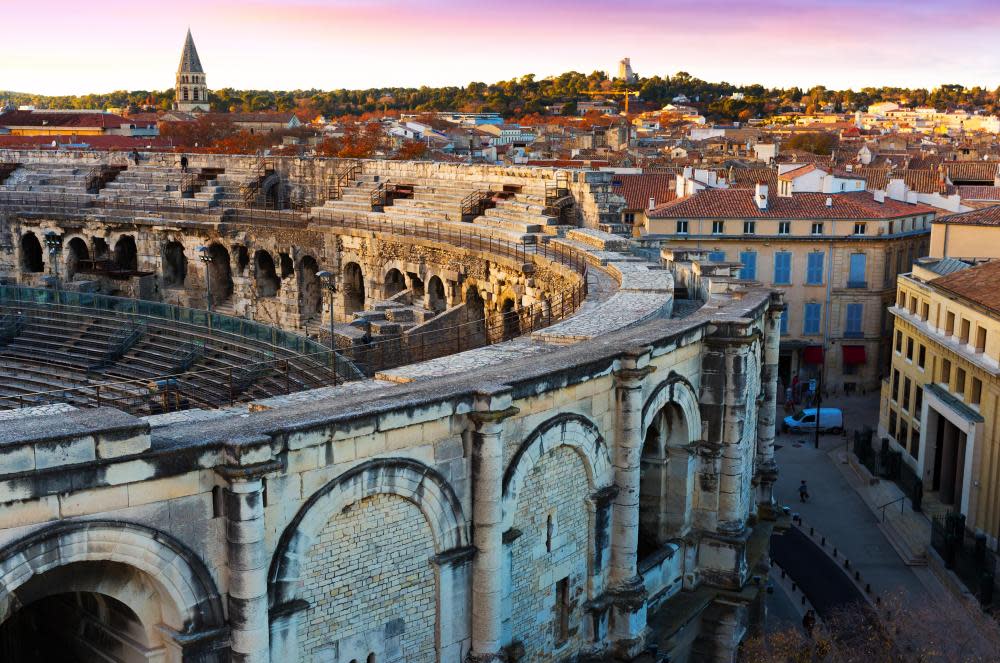
Nîmes, France
Fastest journey from London 6½ hours via Paris
Cheapest Nov fare with Eurostar £168 return
With its remarkably well-preserved Roman amphitheatre plus its new museum of artefacts, not to mention great shops and restaurants, Nîmes makes a superb autumn destination. The crowds have gone and although the intense heat has rescinded, the surrounding hills trap the summer temperatures, making it warm enough to sit out on a cafe terrace and watch the world go by.
Make your first port of call the amphitheatre - Les Arènes (entrance €13, including the other two Roman attractions mentioned below). Explore the interior corridors (vomitories), then climb to the top of the terraces to see the amphitheatre (133 metres long by 101 wide) in its full glory. The top tier also offers views of the surrounding hills (seven, just like Rome), including Mont Cavalier, the highest point of the city, on which the Roman Tour Magne, built by Augustus, stands sentinel.
Opposite the amphitheatre, explore the Musée de la Romanité, which opened in 2018 and holds a fascinating collection of artefacts, from large and exquisite mosaics to statues and glassware that survived 2,000 years buried in sarcophagi. There are interactive exhibits, too, which help bring the history to life. The museum’s own architecture is also impressive – from its glass mosaic-tiled facade that represents the ripples of a toga, to the different levels within the museum that allow you to view the exhibits from above.
Next stop should be Nîmes’ old town: the warren of streets that runs north of the amphitheatre is punctuated with sunny squares, cafes and restaurants, along with independent boutiques for clothes, jewellery and homewares. Stop for lunch at Le Vintage, where you can devour bistro classics on its pavement terrace. Skip dessert though, because the best ice-cream and patisserie in town is a few steps away at Maison Villaret, which was established in 1775. Try its speciality, croquants – delicate almond biscuits flavoured with orange water. Nîmes is also famous for another kind of biscuit, caladons, with almonds and honey.
The old town opens out into a grand square where La Maison Carré, the only surviving intact Roman temple in France, stands proud on a plinth with bright white pillars. Inside, there’s a screening of the film Nemausus, the Founding of Nîmes.
Nearby, the Jardins de la Fontaine are the town’s breathing space: these ornate baroque gardens feature terraces, statues and ornamental ponds, as well as the remains of the town’s original water source, housed in the remains of the Temple de Diane. Up the hill behind it is the Tour Magne.
For dinner, L’Imprévu serves seafood and Italian-inspired dishes and has a terrace on one of the city’s liveliest squares, Place d’Assas.
Example journey
Take the 09.24 from St Pancras, crossing Paris to Gare de Lyon for the 14.07 to Nimes, arriving at 17.05. Returning, the 07.58 gets to Paris Gare de Lyon at 10.53, then across Paris to Gare du Nord for the 12.13 to London, arriving at 13.30.
Stay
at cosy, beautifully decorated La Maison Rousseau B&B (doubles from €105pn). It’s in a peaceful spot and an easy walk to the main sites.
Carolyn Boyd
Angers, France
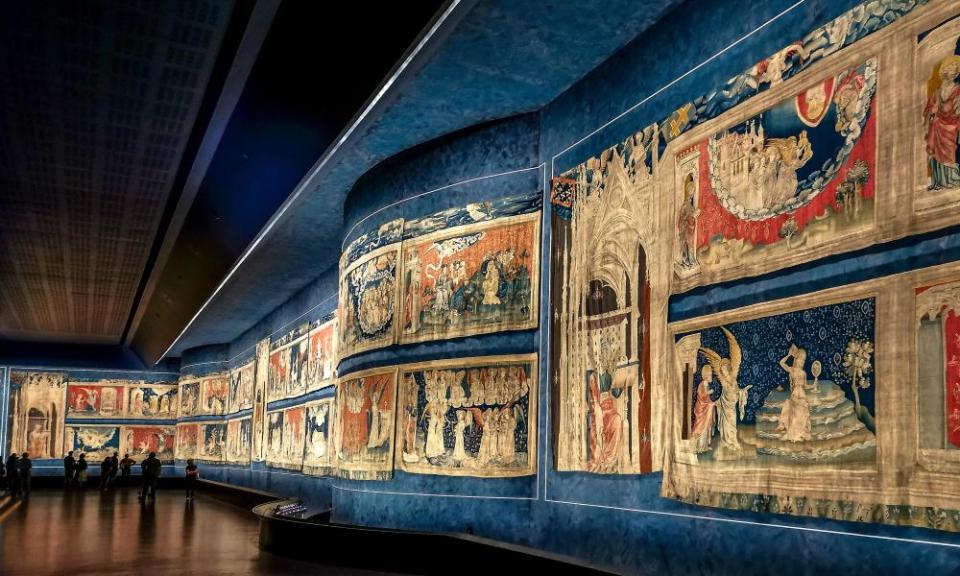
Fastest journey from London 5 hours via Lille
Cheapest Nov fare with Eurostar £95 return
Though it isn’t as well-known as other cities of the Loire, Angers makes the most of its unique position on the River Maine, just before it joins the Loire, with riverside restaurants and enchanting cycle trails, as well as art deco architecture, distilleries and an imposing chateau at the heart of the city.
Château d’Angers is a good place to start. This mighty fortress is surrounded by 17 towers which punctuate its mighty 2½-metre thick walls. For superb views of the city and river, walk around its ramparts, which enclose a tiny vineyard and gardens. Inside, the rooms and exhibits tell the story of the Dukes of Anjou who held court here in the 14th and 15th centuries and were great patrons of the arts. The main draw, however, is the 104-metre Tapestry of the Apocalypse illustrating the Book of Revelations. It took seven years to complete in the late 14th century and its six-metre-high panels, which depict 90 scenes, are beautifully lit in an atmospheric gallery. The chateau’s own restaurant serves good hearty dishes with mains from around €10.
Outside the chateau, follow the blue line painted on the pavements to guide you around a loop of the best sights in the old town. Highlights include the beautiful medieval Cathédral Saint-Maurice with its wonderful stained-glass windows. Just behind it is the six-storey, half-timbered Maison d’Adam, built in 1491 and home to decorative carvings of bawdy figures. A chain department store wouldn’t usually star in a city’s list of must-sees, but the elegant facade and art deco glass roof of Galeries Lafayette will delight fans of fine design. For more art deco, keep following the blue line to La Maison Bleue, an apartment building built in 1929 and decorated with colourful mosaics and ornate ironwork.
Autumn is the ideal time to pedal along the Loire à Vélo cycling track, which follows the famous river. Hire bikes at Vert Event Angers (from €15 a day) and cycle 8km down to the attractive village of Bouchemaine, where Le Noé is one of the region’s many guinguettes – riverside cafe-bistros that offer a host of entertainment, music and activities.
Three kilometres to the east, just outside peaceful Sainte-Gemmes-sur-Loire village, is another hub of activity at Guinguette de Port-Thibaut, with superb views over the broad river. Further down the Loire, a 30-minute cycle away, is the Île Béhuard – an island with monastery and historic chapel at the heart of the characterful village.
Angers is the home of Cointreau: the orange liqueur was created here in 1875 and visitors can tour the distillery. On the other side of town, Distillerie Giffard also has a visitor centre, with a range of liqueurs, including the Menthe-Pastille that made its name.
Example journey
Though most Eurostar journeys go via Paris, it is easier to go via Lille as there is a direct train from there to Angers. It also means you only have to cross the platform to change, rather than crossing Paris from Gard du Nord to Gare Montparnasse, and only one change. Take the 15.04 from London St Pancras, then the 17.52 from Lille. Returning, take the 12.41 to Lille, then the 17.35 back to London.
Stay
Hotel 21 Foch (doubles from €89 room only) is a small, contemporary hotel in the city centre.
CB
Biarritz, France
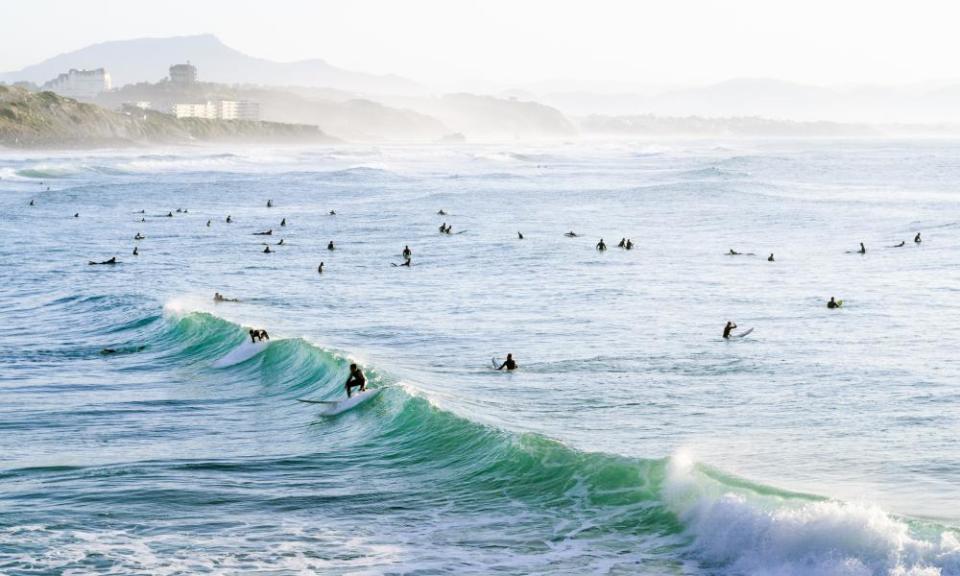
Fastest journey from London 7½ hours via Paris (about an hour longer inbound)
Cheapest Nov fare with Eurostar £120 return
For fresh sea air, fabulous food and Basque culture, a short break in Biarritz fits the bill even in the cooler months. Though its glorious golden beaches and surf culture may suggest it’s a summer-only destination, there is plenty to draw you there in autumn.
Try to time your visit with the Fête de la Saint Martin (8-11 November) to see the town celebrate its Basque heritage through concerts, dance shows, workshops, food events and the Basque racket game, pelota.
Foodies will love Restaurant Week also in early November (4-10), when many of the town’s restaurants showcase their best Basque dishes for €20 for lunch or €30 for dinner. Though you can embrace the French Basque country’s piquant cuisine any time of year at Les Halles market – tuck into pintxos (Basque tapas) and sip local wine at the many stalls.
For goodies to take home, explore the town’s many chocolateries, such as Pariès or Maison Adam, and Rue Victor Hugo, home to the ultimate cheese shop, 1001 Fromages, and the Maison Arostéguy épicerie, which is rammed to the rafters with fantastic Basque and French products.
The other streets that surround the market are great for restaurants, as is Rue Gambetta, leading south from the market. Elsewhere, one of the best tables in town is Le Pimpi Bistrot on Avenue de Verdun, where chef Manu Michel’s dishes showcase the seafood, fish and charcuterie that the Basque country does so well, while nearby locals’ favourite Tantina de Burgos on Place Beau Rivage serves excellent dishes flavoured with the local chilli pepper, piment d’espelette.
Autumn sees the mighty Atlantic waves roll ever more fiercely to shore, and if you dare take to the water there are several surf schools (try hastea.com, 90-minute group lessons from €40) to hire you a board, wetsuit and the guidance of an instructor. A more indulgent way to enjoy the sea, though, is with a thalassotherapy session – seawater therapy – which will blast, drench or sprinkle you with seawater in a variety of treatments said to help circulation and skin tone. Try it at the Sofitel (treatments from €45).
Or to enjoy the ocean without getting wet, take a coastal walk from the lighthouse along the Grande Plage, through the cluster of fisherman’s cabins at Port des Pêcheurs, and on to Le Rocher de la Vierge – a rock formation topped with a Virgin Mary statue, on the site of a miracle. Then follow the road around to the small Plage de Port Vieux, and finish at the incredible Côte des Basques beach. At this end of town, you can also explore the Cité de l’Océan, an interactive nautical museum, which includes a virtual reality surf experience – the cheat’s way to hit the waves.
Example journey
It’s quite a distance, but a relatively quick and very easy way to whizz down to the south of France, and the scenery is a treat in itself. Take the 11.31 from London to Paris Gare du Nord, then from Paris Gare Montparnasse the 15.52 gets you to Biarritz in time for dinner at 19.58. Returning, the 09.58 gets to Paris Montparnasse at 14.08, then the 16.13 from Paris Gare du Nord gets into London at 17.39.
Stay
Hotel de l’Océan (doubles from €69 B&B) is a friendly three-star hotel in the town centre, just above the Port des Pecheurs.
CB
Ghent, Belgium
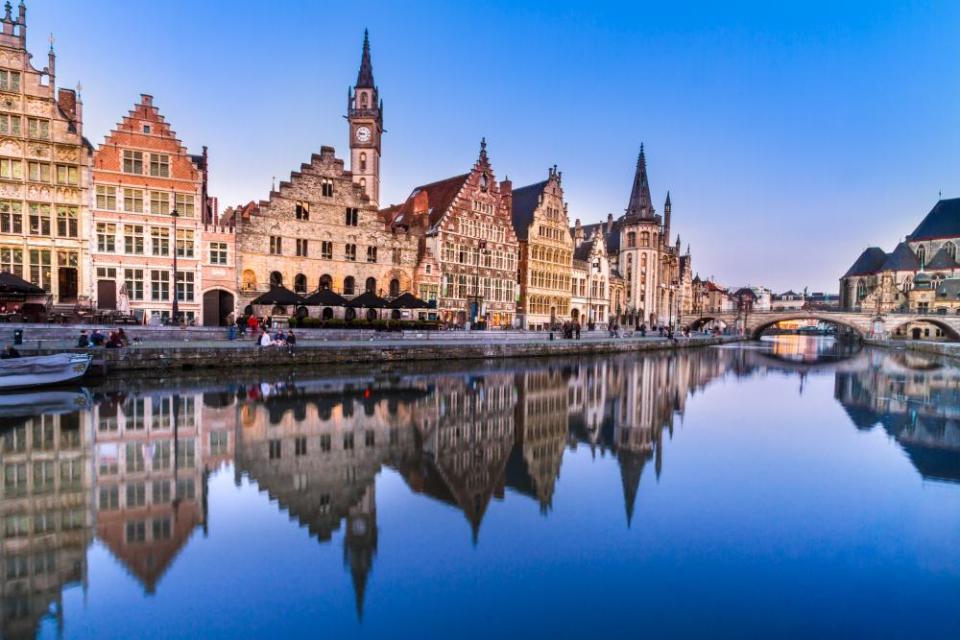
Fastest journey from London 3½ hours via Brussels
Cheapest Nov fare with Eurostar £78 return
Ghent’s cobbled streets, art nouveau townhouses and imposing gothic architecture initially give the feeling of having stepped back in time. But it doesn’t take long to notice the city’s other main appeal: a very modern eco-friendly shopping and food scene.
The vegetarian food is varied and high quality – the city became the first in the world to introduce a weekly vegetarian day a decade ago. For a taste of the veggie scene, head for Lokaal, which serves €12 homely vegan bakes and quiches made using in-season produce, or fill your plate up at a wholesome vegan buffet of colourful salads and pulses at cooperatively run Lekker GEC.
For something higher-end, Lof offers an elaborate five-course vegetarian dinner (€65) that can be paired with vegan wines, while Michelin-starred Vrijmoed has an award-winning seven-course vegetarian menu (€102) that ranges from Japanese-inspired glazed aubergine with kombu seaweed to more typically Belgian fare such as a pavé of goat’s cheese swirled with honey and nuts.
Among Ghent’s other charms are its prettily decorated independent shops. Lots of these sell locally made homeware and decoration, with tea towels, crockery and stationery designed by local artists (a Made in Ghent badge scheme provides helpful signposting). There’s also an emphasis on fairly-made clothing from around the world at shops such as Just Hazel, Visitrice, Mieke and A.puura.a. If you want to shop and relax in a low C02-environment, Broesse is a plant shop which is part tropical jungle, part rattan-furnished cocktail bar, where a young crowd sip creative vermouth-based cocktails surrounded by palm fronds.
It wouldn’t be a trip to Belgium without sampling craft brews. The country’s signature Trappist beers are arguably the original green business model: brewed by monks in small batches that prioritise sustainability and quality, they’re available in most bars. For something more modern, go for a tour and tasting of the home brews in the giant taproom at microbrewery Dok, which is reinventing Belgium’s storied beer tradition with new recipes and flavours; or ascend to historical music venue Vooruit’s relaxed roof terrace to catch the last afternoon rays before winter.
Ghent is also known for its thriving music scene, which keeps up the city’s rootsy image through bands which play anything from punk to futuristic jazz in dimly lit bars like Trefpunt, Bar Mirwaar and Charlatan. The Vrijdag markt is a good place to start a bar-hopping evening – and thanks to the city’s sizable student population, things are lively most nights of the week. Try nights run by the city’s legendary Democrazy promoters.
Getting there
The Eurostar runs from London to Brussels eight times a day and a ticket includes a free onward journey to any Belgian station within 24 hours of departure. Trains to Ghent depart from Gare du Midi, where the Eurostar arrives, every 15 minutes and take 29 minutes.
Stay
Ghent’s Eco Hostel Andromeda (doubles from €68) is a series of simple rooms and colourful shared spaces on a converted barge, and calls itself carbon-neutral. Water is purified on the roof, breakfasts are vegetarian, organic and fair trade, and mattresses are made from natural fibres. For a higher-end but still low-impact option, there’s Studionomie’s chic one-room hotel – the room features furnishings from local designers and Egyptian cotton sheets, all inside a shipping container (double from €130 room-only).
Rachel Hall
Antwerp, Belgium
Fastest journey from London 3¾ hours via Brussels
Cheapest Nov fare with Eurostar £78 return
Antwerp’s most obvious appeal is its winding, cobbled streets culminating in the spectacular gothic cathedrals of the Grote Markt. But Belgium’s second city is its uncontested capital of cool. It has a longstanding reputation as an international fashion hub, buoyed by the fame of the Antwerp Six, a group of designers who graduated from the city’s art school in the early 1980s, but it’s also a port city, where bars, clubs, art galleries and restaurants vie for space in converted warehouses.
Those looking for Antwerp’s hipper side should head to the formerly seedy docks area in the north. MAS, a skyline-dominating red brick and glass block, is a museum that explores the city’s maritime heritage where you can ascend to the roof for spectacular city views free of charge. Nearby is aBc, a brewery and taproom, which produces beers exploring Antwerp’s brewing history, from the Seefbier, based on a 16th-century recipe, to Bootje’s Bier, spiked with ginger and coriander. Move on to grungy Het Bos, a former anarchist squat turned cultural centre that hosts an eclectic mix of gigs, film showings, workshops and pop-up dinners.
The city’s post-industrial appeal extends to the south. One of the highlights is Pakt, a sustainably run warren of progressive businesses in a disused factory. The heat from the pizza oven warms the offices on the top floor, and laid-back restaurant Racine sources vegetables for its seasonal salads and cold-pressed juices from its rooftop garden.
For more traditional flavours, the legendary Frituur No 1 does Antwerp’s most famous chips and mayo, presided over by owner Maria’s unique, occasionally brusque style of service.
The city is a shopper’s paradise and winter collections will be arriving in store now. The most obvious stop off is its fashion strip, Nationalestraat. Antwerpians particularly love “concept stores” that mix fashion, lifestyle, food and art, such as Stay, which champions “slow shopping” by serving cappuccinos and style advice to encourage people to take their time and choose beautifully made pieces they’ll keep forever. Visitors on this street should also rifle through pre-loved pieces at Melting Pot Kilo, which sells vintage threads by weight.
A five-minute walk away, towards the sea, is Kloosterstraat, an iconic strip of antique shops, art galleries, vintage boutiques and designer outposts – try Five Fridays for Scandi style or Made By Hand, which showcases handcrafted jewellery and beautiful knits by local designers.
Getting there
See Ghent, above, for Eurostar details. Trains to Antwerp depart from Gare du Midi, where the Eurostar arrives, every 15 minutes and take from 45 minutes to an hour, depending on the train.
Stay
The stylish Hotel Indigo (doubles from €115 room-only) is part of a small international chain with decor in contrasting shades of pink and blue, with velvet and brass accents. Hotel Julien (doubles from €140 room-only), echoes Antwerp’s signature mix of the historical and contemporary with beautifully renovated rooms in a 16th-century building.
RH
Rotterdam, the Netherlands
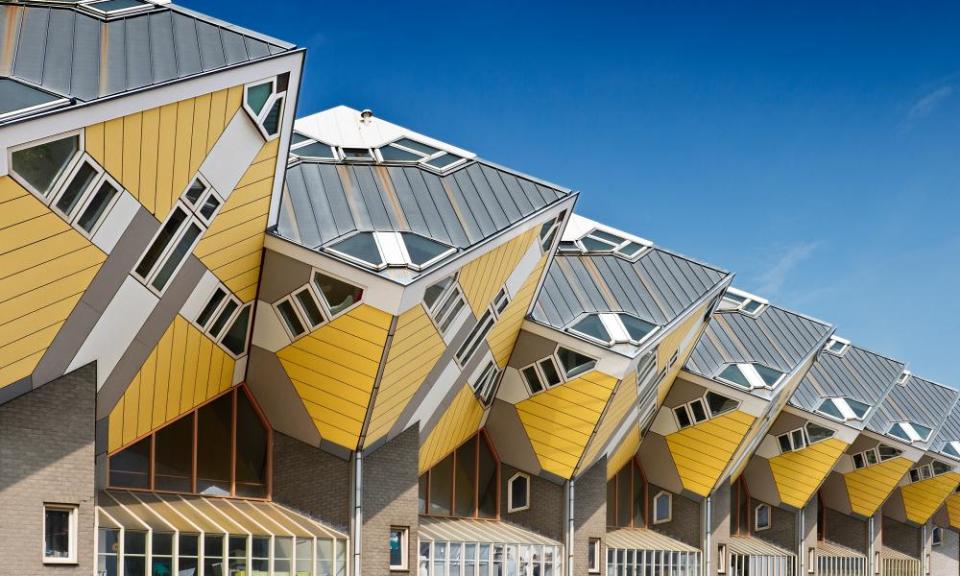
Fastest journey from London 3¼ hours direct (4 hours inbound)
Cheapest Nov fare with Eurostar £86 return
The Netherlands’ second-largest city has world-class museums and galleries, excellent seafood and a feisty spirit – which makes it perfect for those who want to see the “real” modern Netherlands, away from the tourist hordes of Amsterdam. Autumn is the perfect time for a short break.
Rotterdam’s biggest attraction is probably its architecture. Bombed heavily during the second world war, the city today boasts several daring modern tower blocks which would not look out of place in Manhattan. Begin your day with a walk along the riverbank to take in the skyline, perhaps followed by a visit to the famous Cube Houses, an apartment building which looks like a string of discarded yellow Rubik’s Cubes.
Nearby stands the Markthal, a striking indoor food market housed in a building that looks like an upturned horseshoe. Browse the stalls and enjoy a basket of kibbeling fish nuggets, some local cheese or perhaps a glass of jenever (gin) brewed in nearby Schiedam.
Rotterdam grew prosperous thanks to its location near the mouth of the River Rhine, and the city’s giant port – the largest in Europe – has given it a tough, streetwise character.
However, it also has a lively cultural scene. Highlights include the Fotomuseum photography museum and the Kunsthal art museum, which this autumn displays photographs by Daniël van de Ven telling the story of Rotterdam’s astonishing postwar rise.
If you feel like roaming further afield, take a tram or metro to Delfshaven, where old sailing barges line the canals and you feel you might bump into Rembrandt or Vermeer around every corner.
In the evening, watch the sun set as you walk over the famous Erasmusbrug (Erasmus Bridge) which connects the north and south sides of the city (once neglected, the south is now being gentrified). Have dinner at Hotel New York, a grand brownstone building perched imperiously on the riverside. Soak up the panoramic views and dine on local mussels cooked in Pernod or fresh chilled crab legs. Afterwards, walk over the nearby footbridge to Fenix Food Factory, a hipster food market and craft brewery where the glasses are always half full. If the dark local beer goes to your head, you can always order a water taxi to zip you back across the river to bed.
Example journey
The Eurostar goes direct from London St Pancras to Rotterdam Central seven times a day (five times on Saturdays): depart at 07:16 and arrive at 11:32. Returning, border restrictions mean you will have to change trains in Brussels: depart Rotterdam at 16.58 and arrive Brussels Midi at 18.08. You will then have time for a quick coffee before boarding the 18.56 Eurostar to London, which arrives at 19.57.
Stay
Hotel Bazar (doubles from €70 B&B) is quirky, colourful and surrounded by lively bars and restaurants.
Ben Coates, Netherlands-based author of The Rhine: Following Europe’s Greatest River from Amsterdam to the Alps
Arnhem, the Netherlands
Fastest journey from London 5¼ hours via Amsterdam or Brussels
Cheapest Nov fare with Loco2 £140 return
As first impressions go, Arnhem railway station makes a grand statement. A soaring modernist structure made of undulating glass, exposed concrete and steel, it took two decades to build, at a cost of €37.5m. It ushers travellers into a city that has had its fair share of makeovers – most notably after the second world war battle in 1944, depicted in the film A Bridge Too Far, which left only 212 houses undamaged.
Right outside the station is the 1oo-metre-long art wall called The Reconstruction. Painted by local artists and residents, it displays figures and events that played an important role in rebuilding the city. One of the icons is Marga Klompé, who in 1956 became the Netherlands’ first female cabinet minister, and whose work led to the social welfare law.
The story of Operation Market Garden, the biggest airborne landing operation of the second world war, is told at the Airborne at the Bridge museum, the British headquarters during the battle. It’s next to the John Frost Bridge over the Lower Rhine – the one that British, Canadian, Polish and American forces tried and failed to capture.
Today, Arnhem is a city of fashion and design. Its art academy was home to internationally acclaimed fashion designers such as Viktor & Rolf and Pauline van Dongen, and industrial designer Marcel Wanders. For unique items made by a local designer, visit the fashion district in the Klarendal neighbourhood, with its many studios and boutiques – try sustainable fashion label Studio Elsien Gringhuis, or Atelier Judith van den Berg for beautiful, handmade leather bags.
Afterwards, go for a bite atop Karendal’s hill at cafe/restaurant Sugar Hill, popular among Arnhemmers for its no-nonsense food (quality burgers, sandwiches, and three-course meals) and calm atmosphere. A 10-minute walk away is Café Restaurant Caspar, with a wide variety of craft beers, like Mooie Nel (Pretty Nel) or Dunkel CC, and impressively large cups of coffee.
While tourists have taken over the streets of Amsterdam, chances are you’ll have those in Arnhem to yourself. Despite its lively cultural scene – 18 museums and many concert options – the city is less of a tourist attraction, and has a much more laidback vibe. And it’s much greener (or red and orange, this time of year).
For the perfect autumn stroll, and to get your bearings, visit Sonsbeek city park and climb the spiral staircase of the 25-metre 19th-century Belvédère. The tower offers an excellent vantage over the city and its surroundings, but is only open to climb on the last Sunday of each month. Warm up afterwards in Stadsvilla Sonsbeek with a hot chocolate and Arnhemse meisje (sugary biscuit) on the side.
Follow your Sonsbeek stroll with one in Hoge Veluwe national park, a sprawling nature reserve that includes one of Europe’s largest sculpture gardens, featuring 160 artists including Barbara Hepworth, Aristide Maillol, Marta Pan and Pierre Huyghe. The park is also the home of the Kröller-Müller Museum, which boasts the second-largest Van Gogh collection in the world, with nearly 90 paintings and over 180 drawings.
In the evening, make your way to cosy cafe Stella by Starlight, near Arnhem central station, for live music and beers selected by Arnhem’s beer sommelier, Maarten Exel. Or go to cafe Stan&Co, round the corner, to end the night dancing.
Example journey
Take the 11.04 from St Pancras, arriving at Amsterdam at 16.11; get the next (half-hourly) direct train to Arnhem central station (1 hour). To return, take the 13.56 from Arnhem central station, transfer at Breda to Brussels-Midi, arriving at 17:17 (1 hour 35 mins) and take the 18.04 to London, arriving at 21.05.
Stay
Hotel Molendal (doubles from €80 B&B) is in an art nouveau building in Sonsbeek overlooking the park and a stone’s throw from the concert hall Musis Sacrum (home to dance company Introdans) and the city centre.
Caroline van Keeken, Netherlands-based writer and journalist
Wiesbaden, Germany
Fastest journey from London6¼ hours via Brussels and Frankfurt or Cologne (with short transfer times); 7¼ hours inbound
Cheapest Nov fare with Loco2 £125 return
In the 19th century, Wiesbaden was revered as the “catwalk of the society spa”, with royalty, aristocracy and dignitaries from across Europe visiting this elegant town to see, be seen and benefit from the medicinal properties of the water. The heart of the spa town is the Kurhaus, which was rebuilt in 1907 in neo-classical style to house a restaurant, casino, ballroom and concert hall.
The casino is located in the former wine parlour, a handsome room with cherry wood panelling and crystal chandeliers. The roulette wheel where Russian novelist Fyodor Dostoyevsky allegedly lost his fortune in 1865 – and which inspired his short novel, The Gambler – is on display. It’s a pleasant way to while away a few hours, and a few euros, in splendid historic surroundings, while sipping a glass of sparkling Henkell trocken, the locally produced sekt sparkling wine.
To experience the healing water, try the Kaiser-Friedrich-Therme, a beautifully restored art nouveau baths with green-tiled interior and Roman frescoes. As the nights draw in and temperatures drop, do as the Germans do and go textile-free into the tranquility of the soothing, warm water.
If art nouveau decor piques your interest, the Museum of Wiesbaden’s recently opened permanent exhibition is a must. It’s one of the most important private collections in Europe, donated by local patron and former art dealer FW Neess with over 500 original objects, paintings and pieces of furniture – look out for the Nature sculpture by Alphonse Mucha, and furniture and glass pieces by belle époque designer Louis Majorelle.
Art and spas aside, wine is the reason many visitors come to Wiesbaden. Known as the “gateway to the Rheingau”, the most distinguished wine-growing region in the Rhine valley, this is the place to discover refined rieslings or a full-bodied spätburgunder. Among the stalls overflowing with flowers, fruit, cheese and bread, the Wiesbaden Winegrowers stand can be found at the weekly Saturday farmers’ market, where various wineries take turns to present their produce to try for a few euros a glass. For a more formal tasting, Balthasar Ress in the centre of town offers wines at good-value winery prices, along with plates of local cheeses, meats, gherkins and bread.
This chic little town is also home to one of the few urban vineyards in Germany, the Neroberg. Take the cute yellow funicular train, the Nerobergbahn up to the hillside estate for panoramic views across the vineyard, town and over the Rhine to Mainz. From here, there are various nature trails through the forest to enjoy and a magnificent, if a little incongruous, Russian Orthodox church, an opulent monument to Princess Elizabeth Michailowna, the Russian wife of Duke Adolph von Nassau, who died here in childbirth. For something more testing, the Kletterwald Neroberg offers 10 gradients of rope-slung courses high in the treetops, a great activity for families with children aged four and over.
Head back into town for a shopping spree along upmarket Wilhelmstrasse and get cosy in Webers Wikinger for a traditional fireside schnitzel, roast potatoes and more of that glorious riesling.
Example journey
Take the 08.55 Eurostar from London St Pancras, arriving in Brussels at 12.05; board the 12.25 to Frankfurt Airport, arriving at 15.16; then depart for Wiesbaden on the 15.50, arriving at 16.10. The return journey leaving Wiesbaden at 07.41 arrives in London at 14.05.
Stay
The laid-back Hotel Klemm (doubles from €90 B&B) occupies a smart red-brick art nouveau villa and has a stylish decor.
Celia Topping
Cologne, Germany
Fastest journey from London 4 hours via Brussels
Cheapest Nov fare with Eurostar £115 return
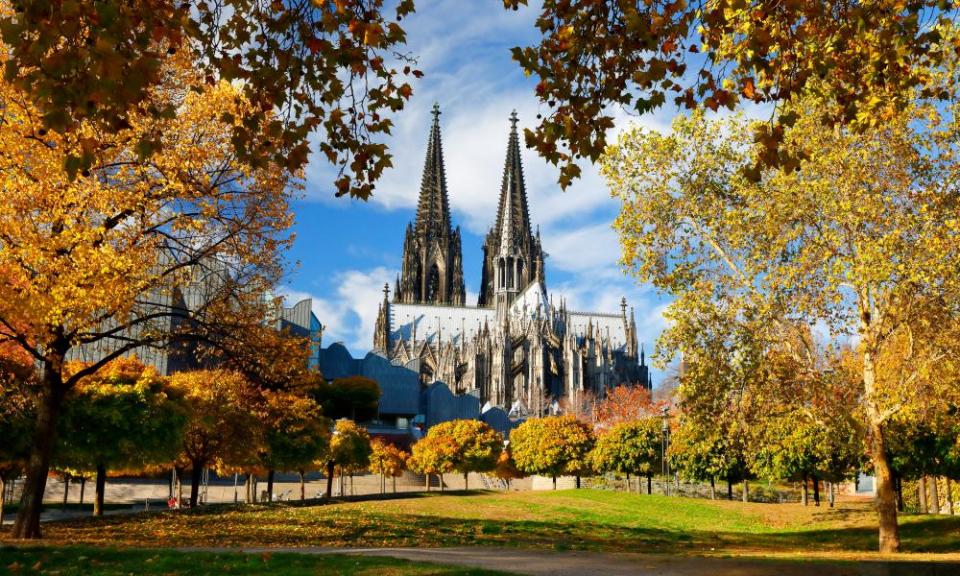
Cologne station is in the shadow of the city’s dramatic gothic cathedral. It’s well worth a trip up the 533 steps, past Fat Pete (the largest free-swinging church bell in the world) and up to the observation platform for panoramic views of the city and beyond. Walking south from the cathedral takes you through the charming cobbled streets of the old town, with its skinny pastel-coloured houses and architectural gems such as the Romanesque Gross St Martin church. Enjoy a traditional halve hahn (gouda cheese with a rye roll, raw onions, pickles and a dollop of mustard) from Peter’s Brauhaus and wash it down with a cold Kölsch, the local beer.
Venturing further south along the river will take you to the recently modernised, popular waterfront district of Rheinauhafen. The Kranhäuser (crane towers) dominate the skyline of this former industrial dockland area, and the curious blend of old and new buildings makes for an interesting stroll. On a chilly autumn day, warm up in the boat-like Chocolate Museum, reached by a swing bridge, and enjoy fine Rhine views.
The west is traditionally seen as the classy side of the river, whereas the east bank was known as Schäl Sick, the rather undesirable “wrong” side. But things have changed in recent times, with prices pushing residents over the river, and regeneration projects such as the Rheinboulevard making a trip across the Hohenzollern bridge genuinely worthwhile – rather than just for “that photo” of the bridge and cathedral.
Turn left and head north from the bridge, stopping for a drink at the Rheinterrassen, and onwards through the Rheinpark, one of the region’s green spaces. From here, catch the Kölner Seilbahn (cable car) back over the river to Cologne’s truly wonderful zoo. This is a zoo for people who don’t like zoos, with happy animals that produce lots of babies, huge enclosures and a delightful programme of special events. But if this really isn’t your thing, the botanical gardens are just next door, perfect for brisk autumn days, with a deliciously warm Palm House and beautiful greenhouses filled with tropical plants.
With two such exceptional attractions nearby, the Sculpture Park often goes unnoticed, which is a shame, as this small, free-to-enter park houses a remarkable collection of international contemporary sculpture, and is newly curated every two years. Cologne is also home to several superb museums, including the Roman-Germanic Museum and Museum Ludwig. If you can, plan your visit for Museum Night on 2 November, for over 200 concerts, exhibitions, DJs and other artistic events at locations across the city until 2am.
For a more low-key evening’s entertainment, head over to the hip Belgisches Viertel (Belgian Quarter), buy a Kölsch from a kiosk and go people-watching in Brüsseler Platz as night falls. From here it’s a short step to some of the area’s coolest bars, with classics like the super-popular Sixpack, or Salon Schmitz, where the bold and beautiful of the city go out in style.
Example journey
Take the 8.55 Eurostar from London, arriving in Brussels at 12.05; catch the 12.25 to Cologne arriving at 14.15. The return journey leaving Cologne at 08.55 arrives in London at 14.15.
Stay
Maison Marsil (doubles around £95 room-only) is in the old town between the Rhine and the Belgian Quarter.
CT
Lausanne, Switzerland
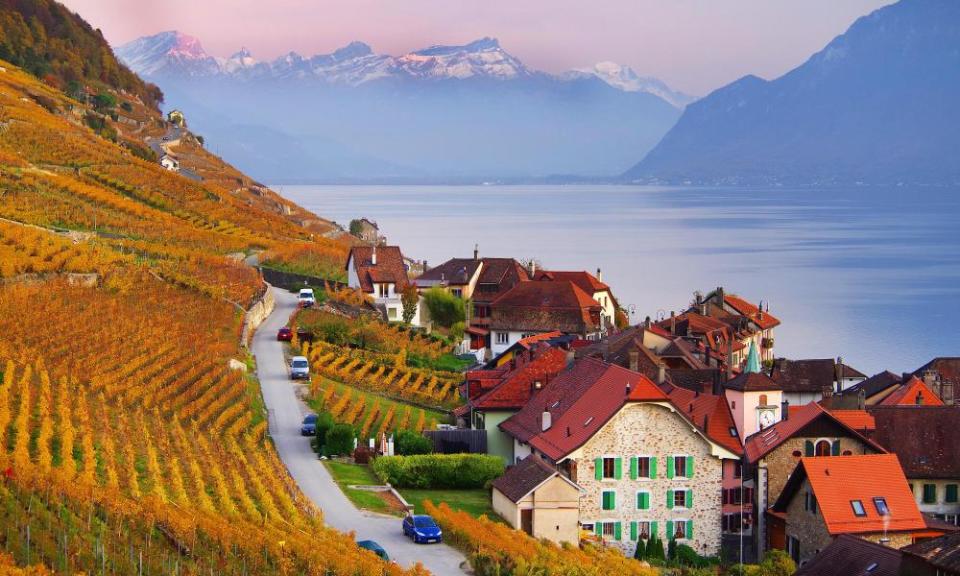
Fastest journey from London 7¼ hours via Paris
Cheapest Nov fare with Loco2 £175 return
There’s a back-to-work atmosphere in Lausanne each autumn, after a summer in which most people spend their free time lazing by Lake Geneva or escaping the heat for the cool of the mountains, leaving the city centre in a slumber. Energy returns in September, building to a crescendo when the Christmas market kicks off at the end of November, sparking a month of vin chaud-fuelled revelry all over town.
In between times, autumn has its own special appeal. For starters, it’s the best season for walking. Head to the terraced vineyards of Lavaux, just outside the city, where the turning leaves are at their most glorious and activity peaks with the annual grape harvest. Taste wine in the various caves as you stroll through the vines between the pretty medieval villages of Lutry and Saint-Saphorin, high above the lake.
Alternatively, Sauvabelin park, on a hill in the north of Lausanne, is a lovely spot to wander among kaleidoscopic trees – climb the wooden viewing tower to see the city and lake spread far below. On your way back downhill towards the town centre, stop at the wonderful Fondation Hermitage to see the permanent collection of impressionist and post-impressionist painters.
A new museum district opens in the city this autumn: Plateforme 10, so-called because of its location near the nine platforms of the main rail station, will house three museums by 2021. The fine art museum, Musée cantonal des Beaux-Arts, is the first to move in this October, followed by the Musée de l’Elysée (photography) and Mudac (contemporary design and applied arts).
As it is home to the International Olympic Committee headquarters, Lausanne is also dubbed Switzerland’s Olympic city, and it hosts the Winter Youth Olympic Games next January. The flashy Olympic Museum, in the lakeside resort of Ouchy, south of the city centre, features a temporary multimedia exhibition, with 50 athletes sharing tales of their personal Olympic experiences.
While it’s always fondue time here (Café du Grütli does a good one), autumn in Switzerland means la chasse (hunting season), so game meats are on the menu at many restaurants in October and November, typically accompanied by spätzle (a sort of Swiss pasta), chestnuts, red cabbage and fruit. Try wild boar stew at Brasserie de Montbenon, or venison filet mignon with truffles and grapes at La Croix d’Ouchy, where you should turn up ravenous, since you get two servings.
For a non-game lunch or brunch, Le Pointu is a good bet for salads and tranches (fancy open sandwiches) if you can get a table – it’s hugely popular; or head to Lausanne institution La Chandeleur for a simple sweet crêpe. For an apéro, Les Boucaniers has a good beer list, or try local wines at crowdfunded bar, Ta Cave.
Example journey
Take the 11.31 Eurostar from London to Paris Nord, arriving at 14.47; cross to Paris Gare de Lyon by taxi/metro, to take the 15.57 TGV to Lausanne, arriving at 19.37. To return, take the 13.31 from Lausanne, changing again in Paris, and you’ll be back in London by 21.37.
Stay
The Alpha Palmiers (doubles from €129 room only), a light, bright space with a central tropical garden, near the railway station.
Caroline Bishop, Lausanne-based author
Looking for a holiday with a difference? Browse Guardian Holidays to see a range of fantastic trips


